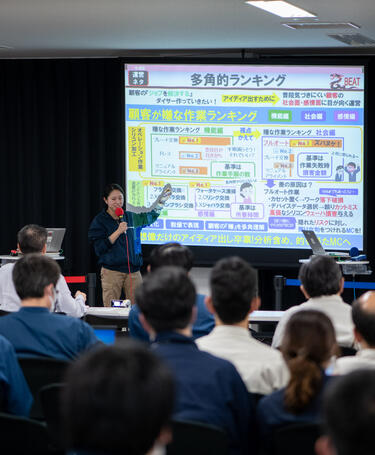
How to motivate all employees to engage in improvement activities: a case study of DISCO Corporation
Progress indicator
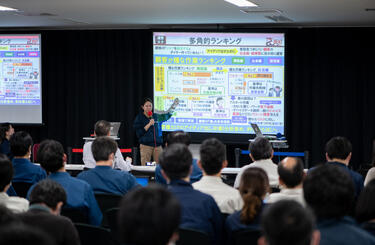
DISCO Corporation, a company which is part of IRCA Japan OEA (Organisation Employing Auditors), provides design and development, manufacturing and related services for precision processing equipment and tools used in semiconductor manufacturing and other industries. In 2003, they introduced unique activities called PIM (Performance Innovation Management). Including PIM, they have established effective systems for motivating of its members, from top management to general employees, to be engaged in improvement. PIM activities are carried out not just at the head office in Tokyo, but also in the nanufacturing plants in Japan and in their local offices around the globe. Among these activities, the PIM matches are an entirely unique approach.
To survive as an organisation and keep succeeding
What is needed for organisations to achieve sustained success in a world where the internal and external context of organisations are constantly changing? When responding to the changing environment, the key factor for the survival and sustained success of the organisation is its ability to improve, change and evolve.
So what is needed for organisations to continue to improve, change and evolve?
The clause ‘11.2 Improvement’ in ‘ISO 9004:2018 Quality management – Quality of an organisation – Guidance to achieve sustained success’, which contains guides for achieving sustained success by improving the quality of business, provides the following guide:
|
Improvement is an activity to enhance performance…. The organisation should ensure that improvement becomes established as a part of the organisation’s culture by: a) empowering people to participate in and contribute to the successful achievement of improvement initiatives; b) providing necessary resources to achieve improvements; c) establishing recognition systems for improvements; d) establishing recognition systems for improving the effectiveness and efficiency of the improvement process; e) engagement of top management in improvement activities. |
But how do you establish a culture of improvement in your organisation? The approaches of DISCO Corporation may give you some useful tips.
Two systems in DISCO Corporation
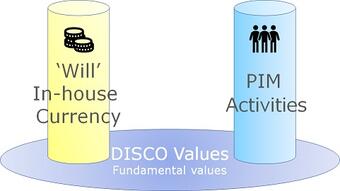
DISCO Corporation has its own fundamental values, called DISCO Values, on which all its business activities are based. This includes many passages, such as “By achieving excellence in all of our corporate activities, our existence will be welcomed by our stakeholders and society”.
Two of DISCO’s systems are based on the DISCO Values. One of such is the in-house currency system, ‘Will’, and another is PIM (Performance Innovation Management).
A system facilitating performance improvement of individuals and teams – the in-house currency, ‘Will’
DISCO Corporation has an individual profitability system using an in-house currency, ‘Will’. Will is used for all jobs in DISCO. When you ask someone to do a task, you need to pay them Will. On the other hand, you receive Will when do a job for someone else. You also need Will to use the company meeting rooms. When looking for someone to do a task, an auction is held using Will. If the work is appealing, someone may take it even though it is for only a small amount of Will. On the other hand, if the work is not worth the amount of Will being offered, there may be no bids, even if it is a large amount of Will being offered.
For example, you Will is also needed for internal audits. If you want your team to be audited by a specific auditor, you have to pay the amount of Will the auditor is asking. Conversely, internal auditors develop a sense of responsibility for providing an audit that meets the value of Will they are being paid.
Mr Tadashi Tamura, System Group Leader of the Quality Assurance Department at DISCO Corporation and IRCA certificated Lead Auditor, says that the individual profitability system has produced positive outcomes as follows:
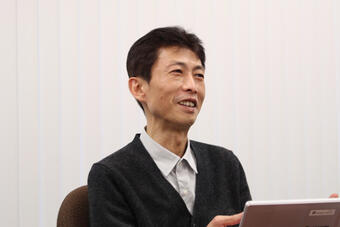
Mr Tadashi Tamura, System Group Leader of the Quality Assurance Department at DISCO Corporation and IRCA certificated Lead Auditor
|
- Being more self-directed towards work Work is auctioned: an individual decides whether to accept the work or not by themselves – Will is “intention”. - Culling unnecessary work: Work not worth paying Will is scrapped. E.g. Will is needed for using a meeting room: Less unnecessary meetings - Work can be flexibly controlled: Employees select their work by themselves. - Move to another department by own choice |
The Will system is linked to the bonuses. Departments and individual employees that earn more Will receive higher bonus.
Most of all, as Will requires individuals to manage their own profitability, every employee develops manager’s mindset.
As described above, the Will system deeply takes root in the operations in DISCO, and it functions as a mechanism for motivating individuals to improve their performance. It is also deeply intertwined with PIM activities, which promote continual improvement, and the unique PIM matches.
A system for engaging all personnel in improvement – PIM
DISCO Corporation launched PIM (Performance Innovation Management) in 2003 as a system to “Continue evolving”. All employees in all department, not just at the manufacturing sites, but also in the supporting departments conduct improvement activities with the goal of zero defects.
PIM activities involve setting target values based on the desired future state for each individual type of work, and then reflecting on the activities at brief intervals to see whether these values have in fact been achieved. The aim of the reviews is to ensure that the organisation as a whole is able to evolve through a process of self-awareness concerning matters such as how improvements can be made. Everyday PIM activities allow them to improve the efficiency of operations throughout the corporation, making DISCO an organisation that evolves in all aspects of its operations.
However, simply asking all employees to participate in PIM activities would not achieve full participation. DISCO uses a totally unique approach to motivate PIM activities – PIM matches.
PIM matches – a unique approach for promoting PIM activities
The clause 8.4 of ISO 9004:2018 Quality management – Quality of an organisation – Guidance to achieve sustained success provides the following guide:
|
8.4 Managing processes 8.4.3 To attain a higher level of performance, the processes and their interactions should be continually improved according to organisation’s policies, strategy and objectives…… The organisation should motivate people to engage in improvement activities and propose opportunities for improvement in the processes in which they are involved. |
Mr Tamura says: “PIM activities make every employee an improvement-enthusiast.”
One of major reasons for this is PIM matches. In a match, each section and department competes using an improvement they have carried out, called an MC (Method Change).
During the match, presenters selected from each section compete with their improvement (MC) by giving a one minute presentation using one PowerPoint slide which summarises the details of the MC, the result of the MC and how they will further develop it in the future.
In the Tokyo Head Office, they have a dedicated floor called the ‘PIM Coliseum’ which is equipped with screens for presenting, and a red corner and a blue corner as a ring for matches. Towards the beginning of the match, employees from other sections and departments come to the PIM Coliseum to spectate the match. These spectators also take part in the matches by voting for the winner in the form of betting will, so all of the spectators eagerly watch.
An important point to mention here is that the top management, Mr Kazuma Sekiya, President and COO of DISCO Corporation, always takes part in PIM matches – not only the ones held at the Head Office, but also at the manufacturing plants and overseas offices. He has a reason why he attends all matches as explained below.
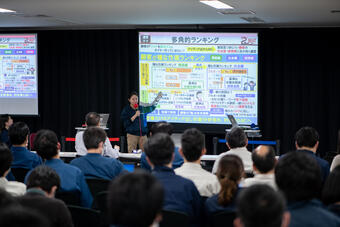
PIM match: The blue corner on the right and the red corner on the left. Mr Sekiya(white shirt, sitting in the front row) and just behind him, the senior managers from each department are attending the match. Almost every time, they have stakeholders such as customers attending who want to spectate PIM match.
For PIM matches, all 86 departments are divided into 16 PIM Promotion Committees, compete in department vs department matches every month. In addition to these matches, there are also leagus consisting of four Promotion Committees, and they carry out PIM league matches every three months to determined the rankings in the league.
In the match we attended, the Human Resources Department and the Administration Department in the red corner competed against the Information Systems Department and the Accounting Department in the blue corner. The match started by calling the presenters to the ring using their ‘ring names’. Each presenter skillfully gave presentations in a compact and summarised manner.
After every round, the spectators are invited to vote to decide a winner. All the employees bet Will on the presentation they believe was better by using an internally developed iPhone application. However, President Sekiya evaluate the content of the presentation, and depending on his judgement, the winner and loser may be reversed. He awards high-level MCs a “Good” award and outstanding MCs a “Super Good” award, and pays a Will prize to the presentations that win these awards. At the end of the match, he also provides critical but fair feedback when he believes there might be more opportunities for improvement, and gives useful tips for further development. Plus, wherever needed, he directly gives instructions and directions to the senior managers relevant to making the proposed improvement. These interactive sessions which take place speedily and directly between top management and employees is another important part of the PIM matches.
The employees who correctly bet Will on the winner receive the winnings sourced from the Will that was bet on the looser. The results may affect each employee’s individual monthly profits, so the spectators are intently focused on the matches.
About 15 years ago, a prototypical PIM match was started by four departments. In 2012, the current style of matches was launched as an activity to promote PIM in the entire company. In 2018 they commenced a grading system resembling that of judo (dani) to rank individuals. In this way, PIM activities themselves are also evolving.
Matches are not only broadcast live via video streaming with the manufacturing plants, but also uploaded to an in-house video distribution system so that the employees can watch the matches afterward. Matches can be planned and carried out in addition to the Promotion Committee and league matches. This kind of matches are also actively planned and hosted.
Culture of improvement and the top management
PIM matches provide opportunities for employees directly engaged in operations, managers, and top management to contact each other directly and communicate interactively. Employees present the improvements that have been made for the processes in which they are involved, the effectiveness of those improvements, and how they will continue to develop the improvement in the future. Top management evaluates the proposals and, where appropriate, gives tips for further improvement. This could be considered another form of a management review.
Having watched the PIM match, we recognised that the critical point of these matches is the fact that the top management, President Sekiya, always attends the PIM matches, including the ones in remote sites and overseas offices, and what is more, improvement activities that are judged to be of high standard are awarded with an appropriate incentive. As such, every employee is motivated, and an internal environment and culture is develped which encourages employees to actively engage in activities to make improvements and increase the company’s operational performance. These unique activities function as a mechanism led by top management.
In other words, it as an example of a policy which embodies the quote cited from “11.2 Improvement” of ISO 9004:2018 at the very beginning of this article to “….Ensure that improvement becomes established as a part of organisation’s culture”.
The clause 7.1 of ISO 9004:2018 provides the following guide on leadership:
|
7.1.1 Top management, through its leadership, should: a) promote the adoption of the mission, vision, values and culture in a way that is concise and easy to understand, to achieve unity of purpose; b) create an internal environment in which people are engaged and committed to the achievement of the organisation’s objectives; c) encourage and support managers at appropriate levels to promote and maintain the unity of purpose and direction as established by the top management. |
How to motivate employees’ engagement, how to recognise their contribution and what kind of incentive to give may vary depending on each organisation’s culture, but the practices in DISCO Corporation may serve as an example.
Already chosen your IRCA course?
If you already know which course you'd like to study, find a course provider near you.
CQI and IRCA Certified Training

Certified training courses on quality and auditing topics delivered by our global network of Approved Training Partners.


